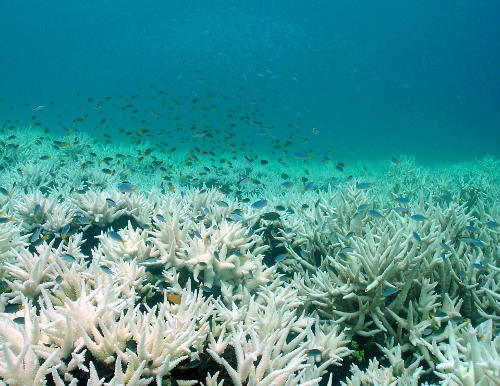Using AI to control energy for indoor agriculture
30 September 2024
Published online 27 February 2018
The frequency and severity of bleaching events have been increasing for three decades, affecting the ability of corals to recover between bleaching incidents.

© Anna Roik
The early 1980s marked the start of formal scientific observation of bleaching incidents, where corals suffered through bleaching on average every 27 years. In 2016, the time span between bleaching events decreased to six years, eventually thwarting the ability of reefs to fully recover.
Bleaching is a stress response in corals; if the seawater temperature exceeds the corals' tipping point, the symbiotic algae that feeds and gives the coral its colorful pigmentation is expelled from the coral skeleton. If warm temperatures persist, corals can die and turn bone-white. Bleaching can also be triggered on a smaller scale by excessive sedimentation around river mouths, pollution and over-fishing.
By monitoring bleaching events on 100 globally distributed coral reef locations, the new research has revealed a very comprehensive dataset of the timing, recurrence, and intensity of bleaching episodes.
"All the indications point to a rapid increase in the rate at which bleaching is occurring," says Michael Berumen, study co-author and associate professor of marine science and engineering at the King Abdullah University of Science and Technology (KAUST). "Think of a patch of rainforest: it is composed of hundreds of different species of trees, bushes and grasses that can take anything from a few hundred years to just a couple years to regrow. With corals it is the same: some corals can bounce back in a few years, whereas other types of corals may take many decades to really reestablish themselves."
As a consequence, the overall diversity of corals on a given reef is decreasing, enabling “weedy”— or in other words, fast growing, smaller and ephemeral corals—to replace old and complex assemblages.
“Just because you have plants does not mean you have recovered the rainforest that was razed,” he adds.
In addition to supporting the call for the reduction of CO2 poured into the atmosphere, which causes spikes in air and seawater temperatures resulting in mass-scale coral bleaching, the study findings also highlight the importance of local management to help corals restore themselves.
David Obura, an adjunct fellow at the Global Change Institute at the University of Queensland in Australia, is the coordinator for CORDIO East Africa, which monitors coral reefs and coastal ecosystems in mainland Africa and in the Indian Ocean island states. He explains that there is not much that can be done about the temperature stress except for global emission cuts, but that it is possible to reduce local threats like sedimentation and pollution, which correlate with bleaching.
“If the coral is facing two or three stresses at once, then it is more likely to bleach than if it is only facing one,” says Obura who was not involved in this study.
In the early 1990s, Obura studied coral bleaching caused by excess sedimentation at a river mouth in Kenya. “The impact I recorded was very localized; corals established 20 kilometers away were not affected."
In response to the shortening periods between bleaching incidents, some communities have opted for active coral reef replanting, while marine scientists are scrutinizing the genotypes of the world's sturdiest corals.
“This next generation approach, called 'assisted evolution', is looking at the genomic structure of resilient corals and studies how this particular genotype could be spread out,” says Berumen. “The Red Sea remains one of the places where we can still learn a lot and hopefully still have time to learn about corals ability to recover or to resist thermal stress."
The scientist expects that the Red Sea model system will help scientists understand how to save corals in other parts of the world.
doi:10.1038/nmiddleeast.2018.23
Stay connected: